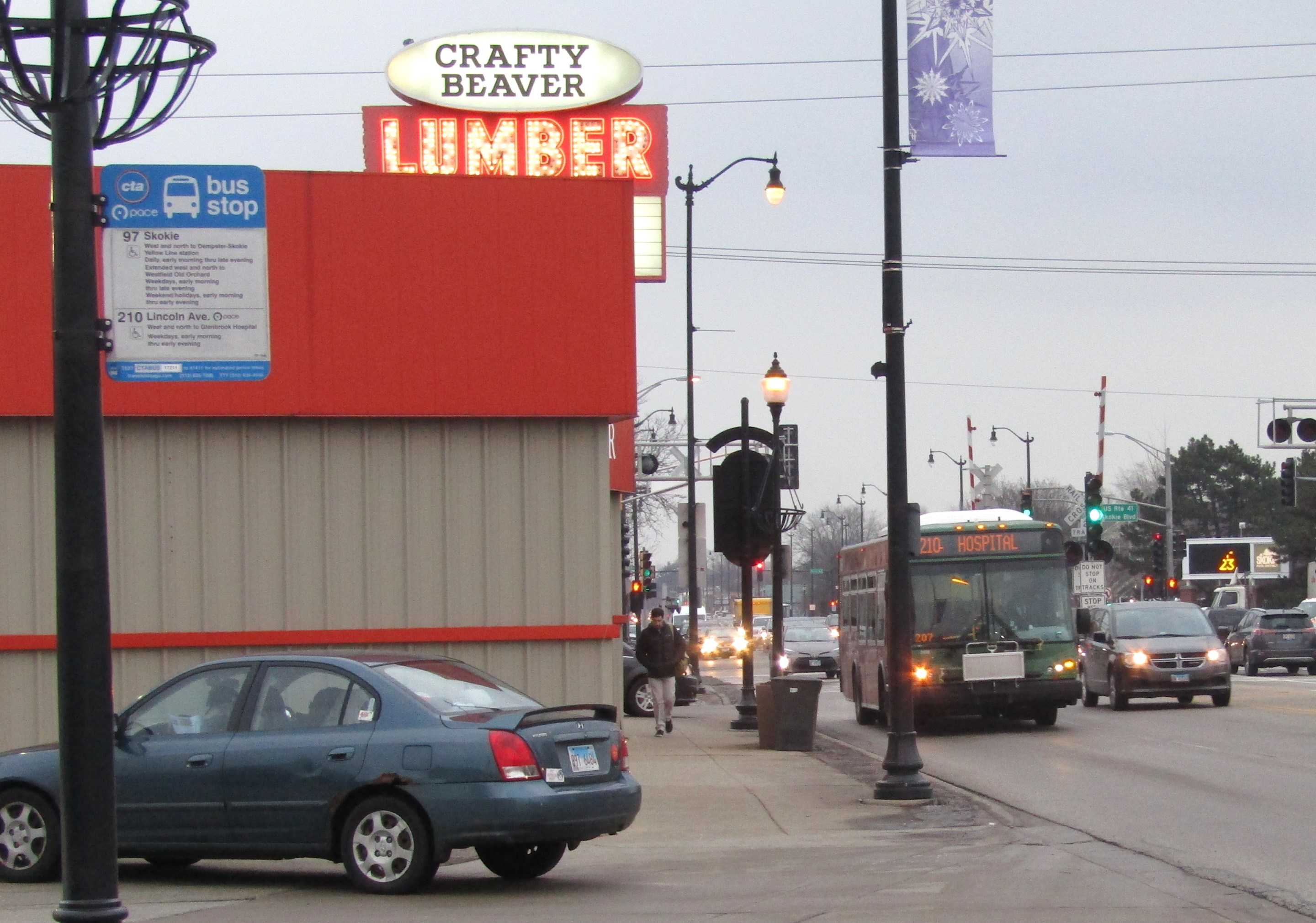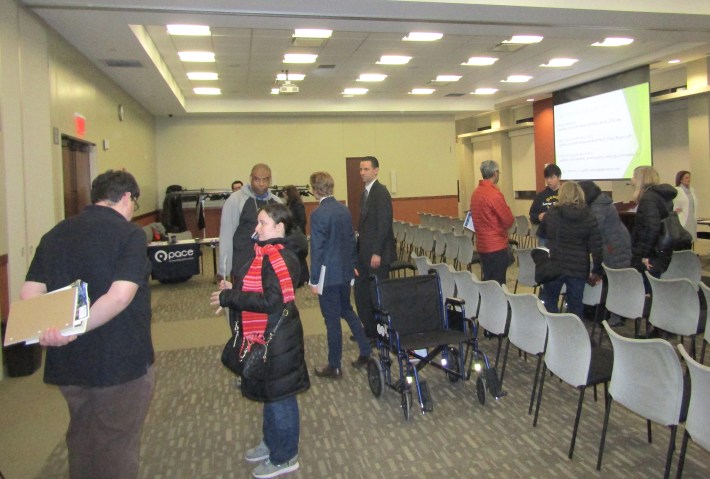Proposed North Shore bus changes raise concerns from Glenview parents, students
10:11 PM CST on February 6, 2020

A Route 210 Pace bus arrives at the Oakton-Skokie Yellow Line station. Under Phase II, the route would be eliminated, but the stop would be served by the revamped Route 226, which would continue west of Oakton Street. Photo: Igor Studenkov
When Pace and CTA unveiled the first phase of the North Shore Transit Service Coordination Plan back in 2018, most of the pushback came from parents and students worried about how the changes would impact schools. Two years later, the same concerns dominated last Friday's hearing at the Glenview Public Library on the next phase of the plan at Glenview Public Library, one of the six such public input meetings.
As the name implies, the plan, which has been in development since 2016, focuses on the CTA and Pace bus routes that primarily serve northern suburbs, with most of the lines serving the affluent North Shore. The idea is to reduce what the two agencies describe as service duplication, adjusting the routes to fit ridership patterns and, in case of Pace, shift to the more grid-based routing that’s standard for CTA.
The first phase of the plan focused on the routes that serve Evanston and Skokie, as well as Route 213, which serves much of North Shore all the way up to Highland Park. Phase II focuses on the routes serving the Far North and Far Northwest sides of Chicago, Lincolnwood, Morton Grove, Niles, Des Plaines, south Skokie, Glenview, Northbrook, Northfield, Wilmette, Kenilworth and Winnetka.
Most of the concerns during Friday's meeting focused on Route 210, which links Chicago’s West Ridge neighborhood, Lincolnwood, Skokie, Morton Grove and Glenview, serving Glenbrook Hospital and Glenbrook South High School. Unlike the other schools affected by the plan, Glenbrook South provides its own school bus service, but parents and students who testified at the hearing argued that Route 210 was a cheaper and faster option, and a useful alternative for students who want to attend after school activities.
Proposed Changes
Most of the changes that are part of Phase II are similar to what was unveiled in the original plan, with Pace clarifying service hours and a few other aspects. Route 210 would be discontinued, with the portion of Route 423 between Dempster Street and downtown Glenview shifted from Harlem Avenue to Waukegan Road to match its current routing in the area. Route 421 would be removed as well, with trips that serve nearby schools shifted to Route 422. The portion of Route 423 east of North Glenview Metra station would be split into a separate Route 424. As Pace officials previously told me, while the two segments have decent ridership, there aren’t many riders who ride between the two segments.
Closer to Chicago, Route 226 would be shifted to primarily serve the section of Howard Street currently served by Route 215 and straightened out at Oakton Avenue portion, eliminating service at downtown Des Plaines Metra station, which doubles as a major Pace transit hub. On the other hand, the change would add evening and weekend service. Route 225, a rush-hour workplace commuter route which follows the same routing as Route 226 before turning west to serve the Howard Street industrial corridor in Niles and Skokie, would become an all-day route with similar hours as current Route 226. Meanwhile, Route 215 would be shifted to start at Jefferson Park Transit Center, serving Foster Avenue and Pulaski Road and resume its current routing at Howard Street. The change would fill in the service gap on the portion of Pulaski between Peterson and Howard, and supplement existing CTA Route 53 further south.
There are, however, two notable changes. While the original plan called from what is now known as Route 424 to take over the portion of Route 422 north of Willow Road, the current plan removes the service altogether. Pace spokesperson Maggie Daly Skoggsbakken told me that it came down to the ridership, which she said was “11 percent of the total route” and argued that alternatives do exist. And while the segment does indeed run near Metra’s Milwaukee District North line, and a less direct connection to Northbrook Court would be possible during rush hour by taking Metra to Lake Cook Road station and transferring to Route 626, riders would lose connections to all destinations in between, including UPS’ Northbrook facility, Glenbrook North High School, and businesses along Shermer and Waukegan Roads. They would also lose a one-step transfer to Routes 213 and 471. And, as Daly Skoggsbaken confirmed, the changes to the schedule would eliminate the final evening trip on Route 422 -- though the special night service to the aforementioned UPS facility would be retained.
The plans to replace most of CTA Route 54A with Pace Route 641 wasn’t included in Phase II. Daly Skoggsbakken said that “it may be considered as part of a future phase.”

Concerns About School Service
During the public hearings held as part of Phase I, a number of Evanston parents expressed concerns that students living along Chicago Avenue would lose direct service to Evanston Township High School provided by CTA Route 205, which was to be replaced by portions of revamped Pace routes 208 and 213. While Pace planned to provide two special, direct school trips that would mimic Howard Street-to-ETHS portion of the route, parents were concerned that wouldn’t be nearly enough. In response, Pace wound up adding five school trips in each direction, but otherwise sticking to the plan.
With Route 210, Pace finds itself in a similar situation. During the Friday meeting, parents and students emphasized that provides direct service between Glenbrook South High School, stopping on the east side of the campus, and parts of Glenview and unincorporated Maine Township. Unlike with ETHS, Pace isn’t planning to replace service on that portion of the route, though it is planning to add one school trip in each direction on Route 422. The attendees argued that wasn’t nearly enough.
Janet Ferrone, of Glenview, said that, as someone who regularly sees nearly empty Route 210 buses passing by from the window of her home, she is well aware of the route’s ridership issues. But her kids do take the bus to Glenbrook South, and so do five other kids on her street – and she argued that the school trips’ departure times would make them less convenient. “Your departure times gives them five minutes to get out of class and onto side of the road [where the stop is],” she said.
While Glenbrook South does have its own school buses, several parents and students argued that Route 210 is a cheaper, faster, and more attractive option. “I'm also the parent of two students who go to Glenbrook South, and very much appreciate that we can pay $600 a year instead of $1600 a year in order for our children to go to school,” said Kathy Szoke, also of Glenview. “I just think Pace bus is safer, more reliable. I know that the route is being replaced, but it's not being replaced with any kind of equivalency.”
She was also among several parents who said that they appreciate that Route 210 lets their kids get to school early and participate in afterschool activities.
Yvonn Wolf said that one of the reasons why she liked living in Glenview was because “it still had some public transit,” which can’t be said for many suburbs further north, and having access to reliable makes kids more likely to take public transportation when they grow up.
Her son, Benjamin Wolf, said that he personally appreciates the advantages of Route 210 – and he has been encouraging his friends to follow suit. “I take the bus early, for jazz band, so do my friends, and we can lug heavy instruments [on the bus]," he said. “I started this year with one other friend who took Pace bus, and now it's about two dozen students who take bus. And I know my friend on the swim team takes the bus,” Wolf added that he gets home faster on Route 210 than some of his friends who take the school bus, because of the circuitous route the school bus takes.
Daly Skoggsbakken provided Pace ridership data that shows that the average daily ridership for stops serving Glenbrook South was between 12 and 14 students. However, it should be noted that afternoon numbers only included the boardings shortly after the school day ends, so the numbers may not be capturing students who are riding home later in the day.
Not all of the concerns focused on schools. Melissa Windover, a regulatory label compliance analyst at Kraft Heinz, said that around 50 of her colleagues who live on the North Side of Chicago take route 210 to the company’s research and development center at 801 Waukegan Rd. in Glenview. While they would still be able to reach the R&D center if the changes take effect, Windower pointed out that it would require transferring between at least two more buses – which would increase their commute from 60 minutes to around 80-100 minutes. Like some of the other speakers, she suggested making Route 210 rush hour only instead of eliminating it altogether. After the public comment portion of the meeting, I saw Windover talking to Pace officials, who suggested vanpool as an alternative.
Dr. Madhu Gorla, an ophthalmologist who practices in several Chicago area hospitals, including Glenbrook South, said that he was concerned that the elimination of Route 210 would hurt patients’ ability to get treatment. He noted that as hospital systems consolidate, chains – such as NorthShore University HealthSystem, which owns Glenbrook South – increasingly put different services at different facilities in different cities. “My concern is people who need transportation to get to the hospital, and there’s no transportation – how are they going to get the care they need?” Gorla said.
Throughout the hearing, Pace officials emphasized that the plans aren’t final and that they would take the feedback received at this and other hearings into account. “During the North Shore Phase I, we went back to make some changes," Daly Skoggsbakken told me in an interview after the meting. “I do think Pace does a good job accommodating [feedback].”
She said that Pace Board of Directors will most likely vote on the changes in either April or May, with the aim of implementing the changes in August, before the school starts.
Stay in touch
Sign up for our free newsletter
More from Streetsblog Chicago
They can drive 25: Residents, panelist support lowering Chicago’s default speed limit
While there's no ordinance yet, the next steps are to draft one, take a committee vote and, if it passes, put it before the full City Council.
One agency to rule them all: Advocates are cautiously optimistic about proposed bill to combine the 4 Chicago area transit bureaus
The Active Transportation Alliance, Commuters Take Action, and Equiticity weigh in on the proposed legislation.



